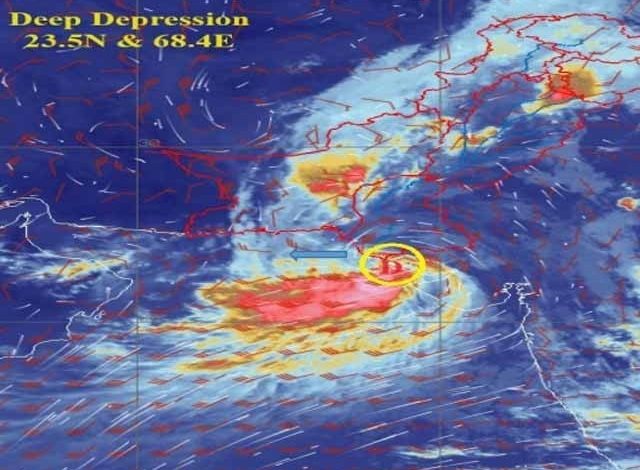Cyclone threat looms over Karachi as heavy rains batter Pakistan

A deep depression located around 250km south-southeast of Karachi is poised to evolve into a rare cyclonic storm as it moves westward towards Oman, raising alarms across Pakistan’s coastal regions.
The Pakistan Meteorological Department (PMD) has warned of the potential storm, which could bring heavy rainfall and strong winds to the southern districts of Sindh, including Karachi, and along the Makran coast.
The depression, which formed over the Rann of Kutch in India, has been moving west-southwestward over the past 12 hours and now lies at around Latitude 23.6 N & Longitude 69.2 E at about 250km east/southeast of Karachi.
Chief Meteorologist Dr Sardar Sarfaraz described the situation as a “rare phenomenon,” stating, “There is an 80 per cent chance for a cyclonic storm’s formation when the deep depression would move from land to the sea and get favourable conditions. It would be a rare event as cyclones are uncommon in the monsoon season.”
Dr Sarfaraz further explained that if the storm materializes, it would be the first cyclone in the Arabian Sea in August since 1976 and would be named ‘Asna,’ a name proposed by Pakistan.
He added that regional cyclones are named according to a list prepared by a 13-country panel, including Pakistan.
Despite the storm not posing a direct threat to Pakistan’s coastline, its impact could still be significant. Torrential rains associated with the storm could lead to urban flooding and inundation in low-lying areas, including Karachi.
“Sea conditions are likely to remain rough to very rough with squally winds 50-60 km/hour gusting to 70 km/hour,” warned the PMD.
In light of these developments, Karachi Mayor Murtaza Wahab has urged residents to avoid “unnecessary movement.”
He took to X, saying, “I would urge the residents of Karachi especially bike riders to avoid unnecessary movement. Stay safe everyone & in case of any emergency call 1339.” The Karachi commissioner’s office has also announced a holiday for schools on August 30 (Friday) due to the anticipated severe weather.
Meanwhile, across Pakistan, incessant rainfall has already claimed nine lives, induced flash floods, and cut off road access in several regions.
In Punjab, seven people lost their lives, and 18 others were injured as heavy rain caused widespread damage to infrastructure and triggered urban flooding in low-lying areas.
According to the Provincial Disaster Management Authority (PDMA), these casualties were reported between 2 pm on August 28 and 2 pm on Thursday.
In Gilgit-Baltistan, two people, including a tourist, were killed, and three others were wounded as rain-induced landslides and flash floods blocked the Karakoram Highway and Baltistan Road.
PDMA’s alert
The PMD’s cyclone alert indicates that the weather system is likely to intensify further into a cyclonic storm by Friday and move initially in a west/southwest direction.
“The deep depression over the Rann of Kutch, India, has slowly moved west-southwestward during the last 12 hours and now lies at about 250km south/southeast of Karachi,” the alert stated.
Under the influence of this system, widespread rain and wind-thunderstorms with scattered heavy to very heavy falls are expected in several districts, including Awaran, Kech, and Gwadar, from August 30 until September 1.
The PMD also cautioned that such torrential rains could trigger pluvial flooding or inundation in low-lying areas of Sindh, Balochistan, and southern Punjab. Flash flooding is also a concern in the hill torrents of Dera Ghazi Khan and local streams in Karachi, Hyderabad, and other areas.
Fishermen in Sindh have been advised not to venture into the open sea until August 31, while those in Balochistan are warned to avoid the sea until September 1.
The PMD’s cyclone warning center in Karachi is closely monitoring the system and will continue to issue updates accordingly.
Dr. Sarfaraz noted that cyclones during the monsoon season are typically short-lived. “They start decaying within a few hours. This happens due to the change in the sea surface temperature and wind’s intensity and direction,” he explained.
Meteorologist Anjum Nazir also highlighted the rarity of such events during the monsoon season, stating, “During monsoon, there is approximately 1% or 2% chance for a depression or low pressure to turn into a cyclonic storm or tropical cyclone.”
Currently, a wet spell prevails over Sindh, particularly the southern and central parts of the province, as well as the neighbouring Indian state of Gujarat. In its wake, the Thar district received the highest amount of rainfall in Sindh on Thursday — 347 millimetres across seven tehsils — according to the PMD.
Rain related incidents
Among other districts, Karachi recorded a cumulative 190mm of rain in the last 24 hours, Mirpurkhas 143mm, while Hyderabad and Badin received 116mm and 112mm, respectively, according to the PMD data.
At least 28 people have died this week from rain-related incidents in the Indian state. Because of the heavy rains battering the coastal areas along the Arabian Sea in Pakistan, and triggering floods in cities in India’s Gujarat state forced thousands of people from their homes.
In Islamabad, meanwhile, the National Disaster Management Authority (NDMA) issued an alert to the departments concerned after more rains were forecast in Sindh, Punjab and Balochistan during the next 24 to 72 hours.

